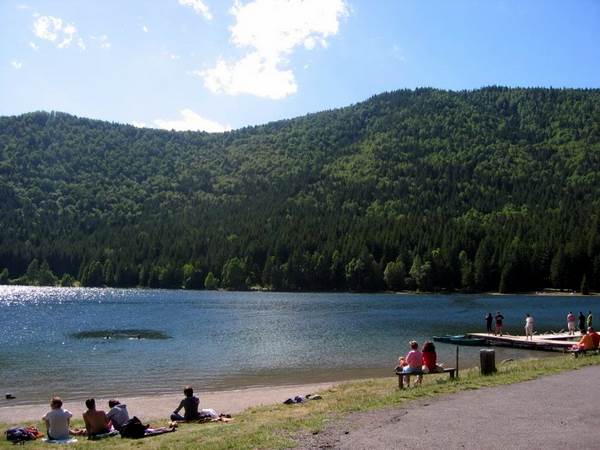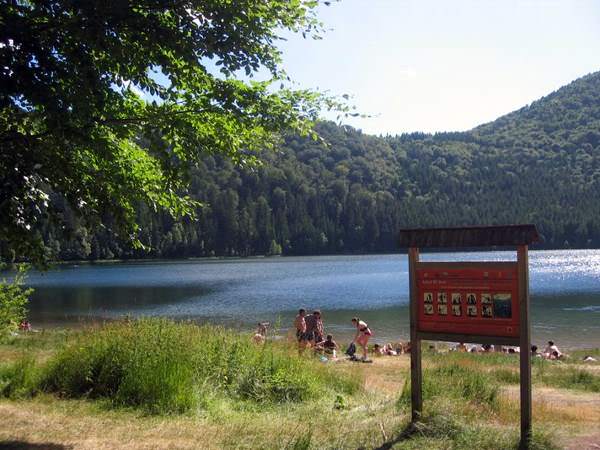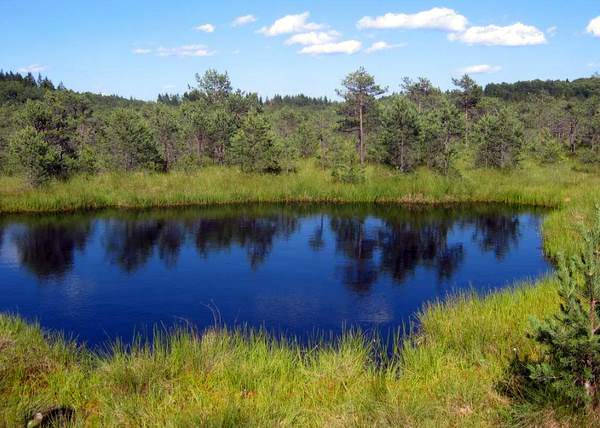In the eastern part of Transylvania, a region of Romania, are two unusual geographical features that are results of the volcanic nature of this area’s geology. While one of them – Saint Anna Lake -is slowly changing, the other – Mohos Lake- is an example of what it is going to turn into.
 Lake Saint Anna (Lacul Sfanta Ana) is a blue-green colored, very calm and beautiful lake formed in an exploded crater 946 meters above sea level. The crater was the result of an eruption 15 millennia ago. The lake is framed by sharply sloping rock coated with coniferous forest, and has an area of about 21 hectares. It never gets beyond 8.3 meters deep, and its average depth is about 4 meters.
Lake Saint Anna (Lacul Sfanta Ana) is a blue-green colored, very calm and beautiful lake formed in an exploded crater 946 meters above sea level. The crater was the result of an eruption 15 millennia ago. The lake is framed by sharply sloping rock coated with coniferous forest, and has an area of about 21 hectares. It never gets beyond 8.3 meters deep, and its average depth is about 4 meters.
All sorts of legends and traditions have built up around this lake. Although it is actually filled exclusively with rain and melting snow, and is not connected to other bodies of water, there’s a persistent legend that it has a subterranean link to some sea.
 On the day of Saint Anna (July 26), the lake is the site of a big procession and a mass held by the Roman Catholics who make up the majority of the local population. The center of this event is the chapel dedicated to the Saint, which sits at the lake’s side. In pre-Christian days, the spot where the chapel stands is said to have been the site of pagan sacrifices. A more worldly tradition associated with the lake is camping. Locals, especially young people, love to descend on the lake on sunny weekends to set up tents, sunbathe and swim.
On the day of Saint Anna (July 26), the lake is the site of a big procession and a mass held by the Roman Catholics who make up the majority of the local population. The center of this event is the chapel dedicated to the Saint, which sits at the lake’s side. In pre-Christian days, the spot where the chapel stands is said to have been the site of pagan sacrifices. A more worldly tradition associated with the lake is camping. Locals, especially young people, love to descend on the lake on sunny weekends to set up tents, sunbathe and swim.
It is known that the lake has been here for more than six centuries, because it is alluded to in a 1349 charter. But it will only be around for another two centuries before it turns into a swamp. In 1870, its depth was 12.5 meters. The lake is getting ever shallower as sediment piles up on its base.
 To get a glimpse of the lake’s future, visit Mohos, located in another crater that’s part of the same mountain. Once a lake three times as big as Saint Anna, Mohos atrophied somewhere between 3,000 and 4,000 years ago. What that means is that so many plants were growing in the lake – especially sphagnum moss – that it became a bog.
To get a glimpse of the lake’s future, visit Mohos, located in another crater that’s part of the same mountain. Once a lake three times as big as Saint Anna, Mohos atrophied somewhere between 3,000 and 4,000 years ago. What that means is that so many plants were growing in the lake – especially sphagnum moss – that it became a bog.
A guided tour of Mohos sets off each hour, and it is a strange experience. When you walk on its surface, you are stepping on a seven-meter moss layer that floats on top of 13 meters of water. To prove this, find a place where the moss parts to give way to a peaty black pool, and jump up and down on what you thought was the ground. You’ll see ripples in the pool.
 The moss is so thick that the water underneath is highly inhospitable to living organisms – the technical term for this is oligotrophic. The same is not true, though, of the moss’s top surface, where there are some rather rare species of life forms. There are three different species of insect-eating sundew here: red flowers that look quite harmless but are able to catch passing mosquitoes. Black vipers live here, too – be careful, as they are venomous.
The moss is so thick that the water underneath is highly inhospitable to living organisms – the technical term for this is oligotrophic. The same is not true, though, of the moss’s top surface, where there are some rather rare species of life forms. There are three different species of insect-eating sundew here: red flowers that look quite harmless but are able to catch passing mosquitoes. Black vipers live here, too – be careful, as they are venomous.
Located only an hour’s drive from the major city of Brasov, these two unusual geographical features can be an interesting day trip as part of a Transylvanian vacation. They serve as a reminder that in this beautiful part of Romania, it is not just the human history and culture that are fascinating: the natural environment is also full of explosive surprises.
Written by and photos by David Hill for EuropeUpClose.com
